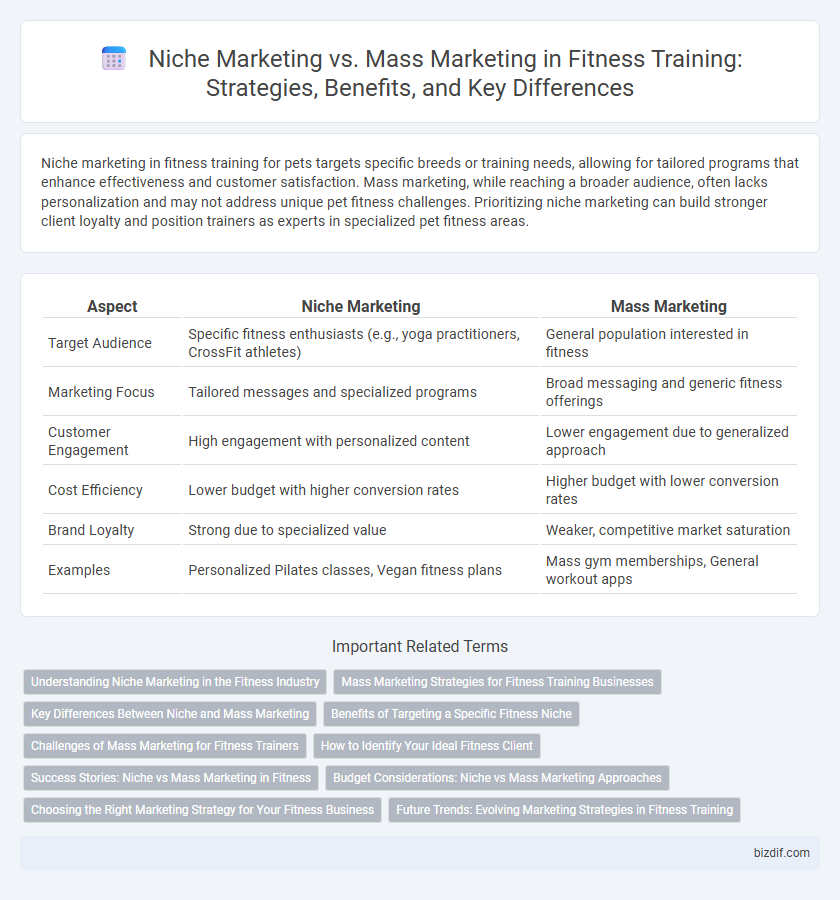Niche marketing in fitness training for pets targets specific breeds or training needs, allowing for tailored programs that enhance effectiveness and customer satisfaction. Mass marketing, while reaching a broader audience, often lacks personalization and may not address unique pet fitness challenges. Prioritizing niche marketing can build stronger client loyalty and position trainers as experts in specialized pet fitness areas.
Table of Comparison
| Aspect | Niche Marketing | Mass Marketing |
|---|---|---|
| Target Audience | Specific fitness enthusiasts (e.g., yoga practitioners, CrossFit athletes) | General population interested in fitness |
| Marketing Focus | Tailored messages and specialized programs | Broad messaging and generic fitness offerings |
| Customer Engagement | High engagement with personalized content | Lower engagement due to generalized approach |
| Cost Efficiency | Lower budget with higher conversion rates | Higher budget with lower conversion rates |
| Brand Loyalty | Strong due to specialized value | Weaker, competitive market saturation |
| Examples | Personalized Pilates classes, Vegan fitness plans | Mass gym memberships, General workout apps |
Understanding Niche Marketing in the Fitness Industry
Niche marketing in the fitness industry targets specific segments such as yoga enthusiasts, senior citizens, or competitive athletes, enabling brands to tailor workouts, nutrition plans, and equipment to meet unique needs. This focused approach drives higher engagement and loyalty by addressing specific goals like weight loss, muscle gain, or rehabilitation that mass marketing often overlooks. Leveraging data on customer preferences and behavior enhances personalized fitness experiences, distinguishing niche brands from broader market competitors.
Mass Marketing Strategies for Fitness Training Businesses
Mass marketing strategies for fitness training businesses focus on broad audience reach by utilizing platforms such as social media advertising, email campaigns, and television commercials to attract a diverse client base. These strategies emphasize standardized messaging about general fitness benefits like weight loss, muscle gain, and improved health to appeal to the widest demographic. Implementing large-scale promotions, affordable membership plans, and accessible class schedules helps maximize market penetration and brand recognition in competitive fitness markets.
Key Differences Between Niche and Mass Marketing
Niche marketing in fitness training targets specific groups such as yoga enthusiasts, marathon runners, or seniors, enabling personalized workout plans and tailored messaging that drive higher engagement and loyalty. Mass marketing aims at a broad audience with generalized fitness programs promoting widely recognized benefits like weight loss or muscle gain, focusing on brand awareness and large-scale reach. Key differences include audience specificity, marketing message customization, and the scale of campaigns, with niche marketing fostering deep connections in smaller segments versus the extensive reach of mass marketing.
Benefits of Targeting a Specific Fitness Niche
Targeting a specific fitness niche enables trainers to develop highly personalized workout programs that address unique client needs, leading to higher satisfaction and retention rates. Niche marketing increases brand loyalty by positioning trainers as experts in specialized areas such as yoga for seniors or high-intensity interval training (HIIT) for weight loss. Concentrating on a defined audience allows for more efficient marketing spend and higher conversion rates compared to broad mass marketing approaches.
Challenges of Mass Marketing for Fitness Trainers
Mass marketing in fitness training faces challenges such as low personalization, making it difficult to meet diverse client needs effectively. Limited targeting often results in lower client engagement and retention rates, as broad campaigns may fail to connect with specific fitness goals or demographics. Fitness trainers struggle with high competition and market saturation, reducing the visibility and impact of generic promotional efforts.
How to Identify Your Ideal Fitness Client
Identifying your ideal fitness client involves analyzing specific demographics, goals, and preferences to tailor programs that resonate deeply within a niche market, improving client retention and satisfaction. Niche marketing in fitness focuses on targeted segments such as athletes, seniors, or weight loss clients, enabling customized training approaches that enhance engagement and results. Mass marketing, by contrast, attempts broader appeal but often lacks the precision necessary to address unique fitness needs effectively, resulting in lower client loyalty and decreased program effectiveness.
Success Stories: Niche vs Mass Marketing in Fitness
Niche marketing in fitness targets specific groups such as triathletes or seniors, resulting in higher client engagement and personalized success stories that drive brand loyalty. Mass marketing approaches reach broader audiences through mainstream campaigns, often generating widespread brand recognition but lower individual client retention. Fitness brands focusing on niche markets report higher conversion rates and long-term growth compared to those relying solely on mass marketing strategies.
Budget Considerations: Niche vs Mass Marketing Approaches
Niche marketing in fitness training requires a focused budget targeting specific demographics, often yielding higher conversion rates due to personalized messaging and tailored services. Mass marketing demands a larger budget to reach broad audiences across multiple channels, increasing brand visibility but potentially diluting message relevance. Efficient budget allocation in fitness marketing depends on campaign goals, with niche strategies maximizing ROI through targeted ad spend and mass approaches benefiting from economies of scale in brand exposure.
Choosing the Right Marketing Strategy for Your Fitness Business
Niche marketing targets specific fitness segments such as yoga enthusiasts or strength trainers, enabling personalized messaging that increases client engagement and retention. Mass marketing appeals to a broader audience with general fitness themes, maximizing reach but often at the expense of lower conversion rates. Choosing between niche and mass marketing depends on your fitness business goals, resources, and competitive landscape to effectively attract and retain your ideal clients.
Future Trends: Evolving Marketing Strategies in Fitness Training
Future trends in fitness training reveal a shift from mass marketing to niche marketing, leveraging personalized digital platforms and data analytics to target specific demographics. Wearable technology and AI-driven coaching enable tailored fitness experiences, increasing customer engagement and retention for specialized fitness niches. Brands focusing on community-building and experiential marketing gain competitive advantages in the evolving fitness industry landscape.
Niche Marketing vs Mass Marketing Infographic

 bizdif.com
bizdif.com